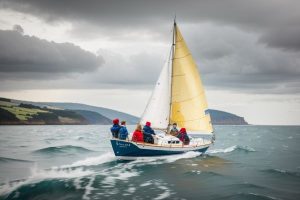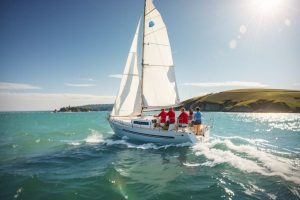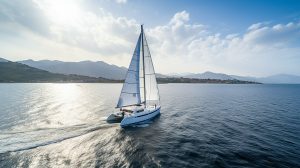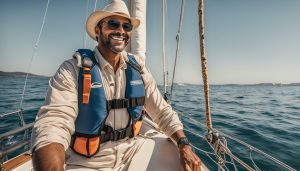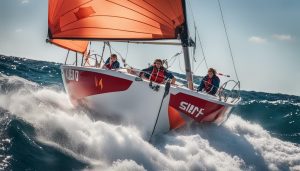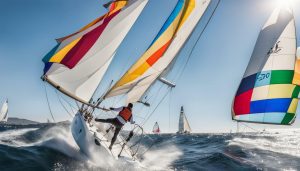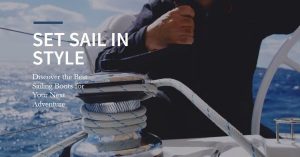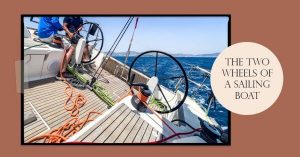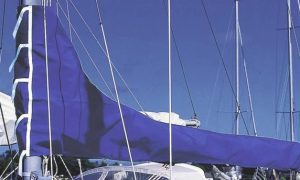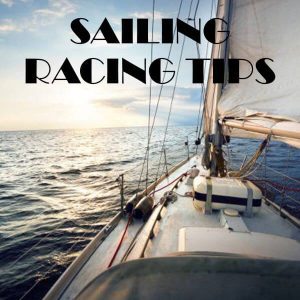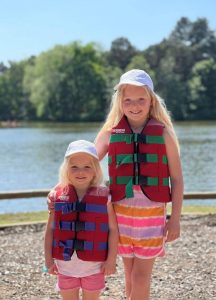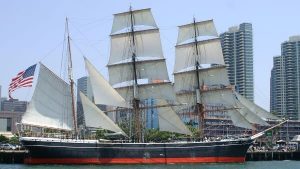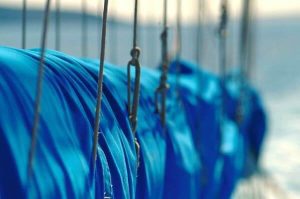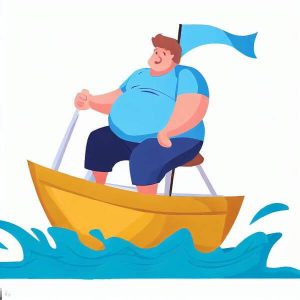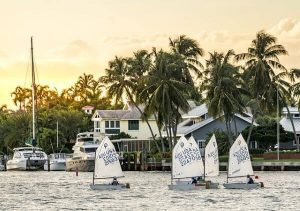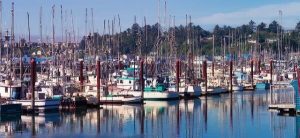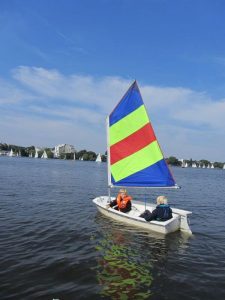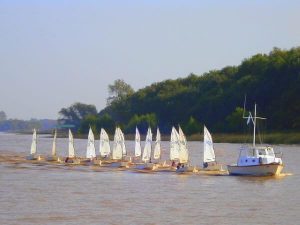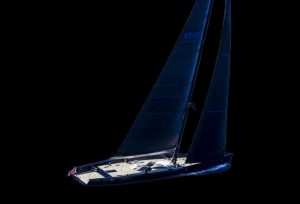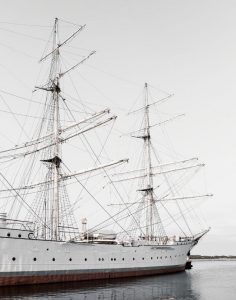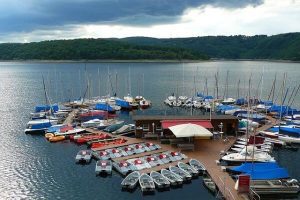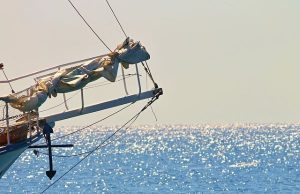The best sailing race tip is to always maintain optimal trim. A well-trimmed sailboat will be faster and more efficient, keeping you competitive in a race. This involves constant adjustments to the sails and rigging in response to wind shifts and changes in boat speed.
TLDR
Apart from the above this article covers the following;
- Sail strategically using geographical effects: Look for low areas that allow wind onto the race course, use trees and man-made features to create sweet spots and wind shadows, and head towards the shore where buildings and streets align with the wind.
- Chase puffs strategically: Meet puffs instead of chasing them, identify geographic effects to find where puffs touch down.
- Adjust tactics based on wind conditions: In light air, go for better pressure, in heavy air, play the shifts. Sail strategically to the windward mark by sailing the longer tack first to increase chances of success, and by sailing towards the next shift to stay ahead of the competition.
- As the crow flies! If you know where the finish line is, just go straight at it unless you're sure there is a bigger advantage to be gained by not doing that. (Often they won't be)
Use geographical effects to your advantage
Sailing racing can be an exciting and challenging sport, with the slightest advantage making all the difference. To gain an edge over your competition, it's important to make use of all the resources available to you. One such strategy is to use geographical effects to your advantage.
- By taking advantage of low areas that let wind onto the racecourse, you can gain precious seconds and increase your chances of winning.
- Trees and man-made structures can also create wind shadows and sweet spots that can impact your speed and direction.
- Finally, heading towards the shore where buildings and streets align with the wind can provide a significant boost.
These tips have been shown to be effective, and they can help you become a better sailor and a stronger racer!
Look for low areas that let wind onto the race course
Low areas that allow wind to flow onto the race course are highly advantageous for sailboat racing. Using geographical effects can make a massive difference in overall performance by increasing speed and efficiency.
- Identify low areas: Look for regions with lower topography where wind gets condensed and accelerates. Such places can be found near cliffs, hills, or mountain ranges.
- Positioning: Position your boat close to these areas such that the incoming wind hits your sail directly. This will increase your speed and agility, making it easier to succeed in races.
- Utilize man-made features: Structures like buildings and streets create sweet spots and wind shadows, so keep an eye out for them while sailing.
- Sail towards shore: Head towards the shore where wind aligns with buildings, trees etc., as this can provide a navigational advantage over other competitors by maximizing exposure to winds.
It is essential to note that geographical effects differ on different racing courses. Therefore effective strategizing and keen observation throughout the race is key in utilizing these techniques effectively.
Sailing downwind is known as "running."
When it comes to sailing, man-made features and trees are your best friends - they create the ultimate wind tunnels to help you race ahead of the competition.
Trees and man-made features create sweet spots and wind shadows
Geographical features are crucial in sailing racing. Trees and man-made features, such as buildings, can create sweet spots where wind flows smoothly, or wind shadows where wind slows down. Identifying these geographic effects can give sailors an advantage over their competitors.
Knowing the exact location of these sweet spots can be tricky, but getting close to them can provide a better possibility of success. Sailors should approach puffs instead of chasing them and identify geographic effects to find where puffs touch down.
In light air conditions, Sailors should go for better pressure while playing shifts in heavy air conditions. Specifically, when sailing towards the windward mark, sailors should sail the longer tack first to increase their chances of success and head towards the next shift to stay ahead of other racers.
Lastly, knowing the racing rules is key when overlapping boats are on a collision course with another boat and the right-of-way rules must be followed.
According to a sailor's experience in a similar race, they were ahead of everyone until they neared some big trees by the shoreline that created a sweet spot of windshadow for those trailing behind them, allowing two other boats to overtake them at once.
Sail towards shore like a pirate chasing treasure, but instead of gold, you'll find sweet spots and wind shadows created by buildings and streets aligning with the wind.
Head towards shore where buildings and streets align with the wind
Sailors can gain an advantage by heading towards the shore where buildings and streets align themselves to the wind's path. This strategy enables racers to catch the wind more efficiently, and it is often associated with better pressure and velocity, particularly in gusty conditions.
By taking advantage of geographic effects and identifying wind shadows, sailors can find sweet spots where puffs touch down rather than chasing them. The wind near the shore generally drives airflow at a low level off neighboring structures, which influences the flow pattern over the water.
This sailing racing tip provides an opportunity for sailors to make tactical decisions based on a thorough understanding of weather patterns in their area. It has been observed that staying close to structures such as buildings, trees or cliffs not only enhances speed but also creates separation from other boats in competition.
In practice, different races have unique variations of this rule. For example, sailors in San Francisco Bay find it helpful to stick close to Alcatraz Island while racers on Lake Michigan follow the shoreline near downtown Chicago. When putting this principle into practice, sailboat captains must be attentive to local topography because each action taken on water depends upon various factors like prevailing winds, vessel speed etc.
Overall, navigating around man-made features strategically may mean that boats have fewer legs and are able to cover less distance during a race. By utilizing this innovative tip effectively while considering all circumstances beforehand that enhance output it is easy for sailors to get ahead of the pack!
"Chase the puffs like you're chasing your dreams, with strategy and determination."
Chase puffs strategically
As an experienced sailor, I’ve found that one thing separates good racers from great ones – the ability to chase puffs strategically. In this segment, we’ll take a closer look at this strategy and how it can help improve your sailing performance. Instead of aimlessly chasing puffs, meeting them head-on is key. Additionally, knowing the geographic effects that determine where puffs touch down is crucial in identifying the most effective route. By implementing these tactics, you’ll be well on your way to becoming a more successful sailor.
Meet puffs instead of chasing them
To increase your chances of success in sailing racing, it is better to meet puffs instead of actively chasing them. Identifying geographic effects can help you to identify where puffs touch down. By adjusting course and strategically positioning yourself, you can be in the right place at the right time to take advantage of a puff.
Sailing towards areas where low pressure combines with geography can help you intercept puffs before competitors. As such, choosing a course around the expected arrival of puffs and leveraging geographic features is a smart approach.
An alternative tactic would be scouting for potential wind holes or obstacles that are likely to cause subtle shifts in air movement. Ultimately, mastering these strategies is key to successfully meeting those critical puffs when sailing.
In a competition held in 2019, a sailor from Geelong's unsuccessful attempt to catch up with the rest of the fleet was attributed to their failure to follow the 'meet puffs instead of chasing them' principle. They chased every puff of wind without considering their strategic positioning on the course which resulted in them falling behind and ultimately losing the race. Unleash your inner weatherman and find the perfect spot to meet those elusive puffs.
Identify geographic effects to find where puffs touch down
To optimize your sailing performance, it is crucial to identify geographic effects that help you locate where puffs touch down. By doing so, you can strategically adjust your position and take advantage of the wind patterns on the race course. A four-step guide to identifying geographic effects to find where puffs touch down includes:
- Look for low-lying areas that allow wind to enter the race course.
- Utilize trees and man-made objects to locate sweet spots and wind shadows.
- Sail towards the shore where buildings and streets align with the wind direction.
- Notice how puffs behave in different locations, especially when they touch down on the surface.
It is essential to learn other unique details related to identifying geographic effects' impact on puffs landing locations. These facts further equip sailors with important strategies in their attempt to improve their performance and gain a competitive edge in racing. As one interacts with sailboats competing on courses, having such knowledge could distinguish skilled sailors from average ones - those who meticulously analyze all factors at play - including environmental, geographical or meteorological - will sail efficiently by capitalizing on every advantage possible. For those who want to become a master at finding best tactics in sailing racing, not understanding this tip means one likely has missed an opportunity to win a tough race! Go for the pressure in light air, play the shifts in heavy air, and always adjust your tactics to Mother Nature's mood swings.
Adjust tactics based on wind conditions
As an experienced sailor, I’ve learned that success on the water often comes down to adapting to changing wind conditions. One crucial aspect of this is adjusting tactics based on wind conditions - a skill that separates skilled sailors from mediocre ones. With lighter air, it's all about finding the pressure and using it to your advantage, while in heavy air, mastering the shifts is key. In the upcoming sections, we’ll explore these tactics in more detail to help you become a more efficient racer and improve your sailing game.
In light air, go for better pressure
Taking advantage of better pressure in light air is vital while sailing. In such conditions, the wind's strength is low, and if you go for better pressure, it will help move your boat faster towards the destination. To get better pressure in less wind, ensure that your sail is trimmed appropriately to maximize the available airflow. Also, it's essential to be watchful of the water surface as ripples indicate the puffs. The area where puffs meet the water known as "touchdown," also impacts pressure.
Additionally, sailboat racers can turn their boats to a certain angle which "hunts" for more pressure instead of sailing directly upwind in lighter winds. The hunt often involves fluctuating angles during small intervals and yields more velocity made good towards upwind goals.
During light-air times when using this strategy rightly comes with advantages over other methods, heavy-air tactics might also come in handy in some cases when there's an opposite trend.
With heavy air comes heavy competition, so play the shifts wisely to leave them in your wake.
In heavy air, play the shifts
When the wind is strong and heavy, strategic sailing by playing the shifts can help in gaining an advantage over competitors. To enhance racing tactics, it is crucial to know how shifting winds affect the boat's performance.
Here's a 3-step guide to playing shifts in heavy air:
- Keep moving to find better pressure or more wind as these spots can change as the wind shifts.
- Stay alert for opportunities to tack and gain speed by tacking on shift headers.
- Position your boat so that you are always sailing upwind or downwind rather than across it. This reduces resistance and lessens the chance of capsizing.
It's important to note that heavy air conditions have different effects on boats, sailors, and navigation tools. Stiff breezes require proper handling of sails, weight distribution, and equipment adjustments.
Sailor Maximilian Soh explained that during a World Championship race in windy conditions, he "played safe while focusing on keeping my boat flat with [the] sails trimmed properly." He also took advantage of heading towards shore where buildings align with the wind to maximize his speed. This helped him secure a win in his class.
Be the captain of your destiny, sail the longer tack first and leave your competitors in your wake.
Sailing Tip: Sail strategically to the windward mark
As an avid sailor, nothing is more satisfying than mastering a perfect race. One of the key elements that separates the successful racers from the rest is the ability to sail strategically to the windward mark. In this segment, I'm going to offer two tips that can increase our chances of success. First, we should sail the longer tack first, which can give us a significant advantage as we navigate the course. And second, by sailing towards the next shift, we can position ourselves to stay ahead of the competition. These tips have been tried and tested by sailing enthusiasts and are sure to give us the much-needed edge at the windward mark.
Sail the longer tack first to increase chances of success
Sailing experts suggest using a strategy that involves sailing the longer tack first to increase chances of success. This is a proven technique that can help sailors gain an advantage over their competitors and increase their chances of winning races.
Here are six steps to follow when implementing this strategy:
- Start by identifying the wind direction and the position of the windward mark.
- Determine which tack will take you closest to the windward mark.
- Sail on this tack for as long as possible, even if it means sailing further away from the mark.
- Monitor your progress and adjust course if necessary to maintain maximum boat speed.
- When you reach a point where you can no longer sail effectively on this tack, switch to the other tack.
- Continue sailing towards the windward mark, keeping in mind any shifts in wind direction that may affect your course.
It's important to note that every race has unique conditions, so it may not always be advantageous to sail the longer tack first. Experienced sailors understand when this technique is most likely to succeed and when it's better to adopt different strategies.
Incorporating this tactic into your racing arsenal increases your likelihood of success on race day by giving you an edge over less strategic competitors.
Don't miss out on improving your racing strategy - incorporate "sail the longer tack first to increase chances of success" into your training routine today! Stay ahead of the game by riding the winds towards the next shift, leaving your competition hanging in the wind.
Sail towards the next shift to stay ahead of the competition
When racing, it is important to stay ahead of the competition by anticipating shifts in the wind and adjusting your course accordingly. By sailing towards the next shift, you can maintain an advantage over other boats. To achieve this, be attentive to wind patterns and monitor changes in direction. However, keep in mind that making sudden drastic adjustments may lead to lost time and distance.
To effectively sail towards the next shift and ensure a lead over your opponents, it is critical to have knowledge of geographic effects on wind patterns, like buildings or man-made features that create wind shadows or sweet spots. Additionally, identifying where puffs touch down and meeting them strategically can make a significant difference in gaining momentum and increasing speed.
Moreover, employing specific tactics according to different wind conditions can help with staying ahead of the competition. In light air situations, sail for better pressure while choosing shifts becomes more productive during heavy air scenarios.
Lastly, sailing the longer tack first helps increase chances of success when navigating towards a windward mark. Plus, aiming your boat towards the next visible shift will allow you to retain a competitive edge over other boats around you.
Knowing the racing rules is key to avoiding collisions and making sure you're not the one saying 'anchors aweigh!'
Great sailing tip: Know the racing rules
As an avid sailor myself, one of the most crucial aspects of racing is understanding the rules of the waterways. In this part of the article, we will explore one of the most important rules to comprehend while racing: the right-of-way rules for overlapping boats on a collision course. By understanding and mastering these critical regulations, sailors can gain a significant advantage in any racing competition. With our expert insights and helpful tips, you'll be well on your way to becoming a top-performing sailor in no time.
Understand right-of-way rules for overlapping boats on a collision course.
When sailing, it is crucial to know and understand the right-of-way rules for overlapping boats on a collision course. This is important to avoid accidents and ensure smooth sailing throughout the race.
Here's a 5-step guide to understanding the right-of-way rules for overlapping boats on a collision course:
- Keep your eyes peeled for potentially dangerous situations.
- When two boats approach each other on opposite tacks, the boat on starboard tack has right of way over the boat on port tack.
- If two boats are on the same tack but different courses, the leeward boat (the one closer to the wind) has rights over the windward boat (the one further from the wind).
- When two boats are overlapped and close together, they must communicate to avoid any potential incidents.
- If an incident does occur and results in contact between boats, both boats should retire from that race.
It is essential to keep these rules in mind while racing as they not only keep you safe but also prevent disqualification from the game.
Pro Tip: Always double-check which side of the boat you're sitting on before making any critical decisions or communicating with other racers when approaching another vessel, as this can help avoid unnecessary confusion or errors.
Five Facts About Sailing Racing Tips:
- ✅ Successful sailors punch out into the first shift, using their speed to stay in the front row half way up a first beat.
- ✅ Trees and man-made features will cause wind shadows and holes, but also will create sweet spots that have more wind, more often, than the rest of the lake.
- ✅ In light air, it is better to sail toward better velocity rather than finding good shifts in wind direction.
- ✅ In heavy air, it is better to sail for shifts instead of puffs.
- ✅ When unsure of the next shift, sail the longer tack first toward the middle of the course rather than the shorter tack toward the layline.
FAQs about What Is The Best Sailing Racing Tip
What is the best sailing racing tip for beginners?
If you are a beginner in sailing, one of the best tips is to start by learning how to control your boat in light wind conditions. This will give you the foundation you need to build your sailing skills in heavier winds. Additionally, it is important to pay attention to the environment around you and identify any geographic sweet spots that will affect the wind and give you an advantage.
What are some learning to sail tips?
When learning to sail, it is important to start by understanding the basic sailing terminology, parts of the boat, and points of sail. Practice sailing in different wind conditions, and pay attention to how the boat responds to different sail settings. Additionally, always wear a life jacket and make sure to stay aware of your surroundings to avoid collisions or accidents.
How can I identify geographic sweet spots in lake sailing?
Look for low areas that will let the wind onto the race course, and pay attention to man-made features and trees that may create wind shadows and holes, but also create sweet spots with more wind, more often. Furthermore, watch for near-shore bands where the airflow accelerates or where there is a heading shift on the tack headed most directly toward the shore that permits a boat to shorten its course by tacking to the lifted offshore tack.
What is the best way to sail on a lake with oscillating wind shifts?
Sail the edges of fan puff to ride the lifts and use your speed to punch out into the first shift. Additionally, in shifty conditions, sailing in the middle of the starting line is usually a good place to be until one end is more than 15 degrees favored. If the oscillations slow down then they become persistent shifts. Therefore, make sure to have an aggressive starting mode and play lifts and headers on the side of the shore that provides port tack lifts.
How can I improve my racing performance in light wind conditions?
In light air, try to look for and sail toward better velocity as a small detour to catch or intercept puffs will help much more than finding good shifts in wind direction.
What is the best way to sail in heavy air?
In heavy air, finding more wind velocity probably won’t help you go much faster or point higher. It’s better to sail for shifts instead of puffs as a good wind shift can enable you to aim closer to the windward mark.
Recent posts:
- Royal Windermere Yacht Club ReviewDid you know Lake Windermere is England's biggest lake? It's 10.5 miles long and 1 mile wide. This beautiful lake is home to the famous Royal Windermere Yacht Club. It's one of the UK's top sailing clubs, making it a great spot for sailing fans and those who love being on the water. The Royal… Read more: Royal Windermere Yacht Club Review
- Coquet Yacht Club ReviewWelcome to the Coquet Yacht Club in Amble, UK. It's known for its yachting community and great marina. Also, see why this club is so well-loved. The Coquet Yacht Club has over 500 members who love boating. They come from many different backgrounds but share a passion for sailing. This club has a long history… Read more: Coquet Yacht Club Review
- Coniston Sailing Club ReviewDid you know about the Coniston Sailing Club in the stunning Lake District? It offers many services and activities for all sailing lovers. The club's beautiful location and great facilities make it a top pick for sailing in the UK. At Coniston Sailing Club, you can learn to sail, hire a boat, or join fun… Read more: Coniston Sailing Club Review
- St Andrews Sailing Club ReviewDid you know sailing is growing fast in the UK? More people are discovering the joy of sailing. If you love sailing or want to learn, check out St Andrews Sailing Club. The club has something for everyone. From beginners to experts, you can learn and have fun. Their instructors teach you everything about sailing… Read more: St Andrews Sailing Club Review
- Derwent Reservoir Sailing Club ReviewDid you know that Derwent Reservoir in Northumberland is famous for both calm walks and exciting water sports? The Derwent Reservoir Sailing Club is loved by many. Families, water sports fans, and those who love adventure come here. The club is in Blanchland, Consett, a nice place for all. Imagine paddle boarding, dinghy sailing, windsurfing,… Read more: Derwent Reservoir Sailing Club Review
- Loch Venachar Sailing Club ReviewWelcome to Loch Venachar Sailing Club, an exciting place! Loch Venachar is in the Trossachs National Park, a top spot in the Scottish Highlands for sailing fans. This club teems with beautiful sights and fun activities, making it a perfect spot for all. Join in the fun at Loch Venachar Sailing Club with sailing lessons… Read more: Loch Venachar Sailing Club Review
- Cardwell Bay Sailing Club ReviewDid you know that sailing is not just thrilling, but also helps you see the coast's beauty? It is well-loved by water lovers around the world. Cardwell Bay Sailing Club is here for you, offering amazing sailing adventures. The club is at the gorgeous Cardwell Bay marina. It's perfect for beginners and experienced sailors alike.… Read more: Cardwell Bay Sailing Club Review
- Clyde Corinthian Yacht Club ReviewDid you know the Clyde Corinthian Yacht Club is over 140 years old? Since 1877, this club on the west coast of Scotland has welcomed sailing fans. It's a place where both new and experienced sailors come together. The club is known worldwide for its excellence in sailing. The club has great facilities like a… Read more: Clyde Corinthian Yacht Club Review
- Ullswater Yacht Club ReviewThe Lake District isn't just about beautiful views. It's also a top place for sailing. Ullswater Yacht Club brings together sailing fans to enjoy the calm and excitement of sailing. It sits in the lovely Lake District. Here, you can join regattas, rent boats, or take sailing classes. This club is known for its great… Read more: Ullswater Yacht Club Review
- Prestwick Sailing Club ReviewDid you know over 1.5 million people in the UK love sailing and water sports? Among these, Prestwick Sailing Club is a top choice. It's on the beautiful Ayrshire coast. Here, you can enjoy various activities, no matter your skill level. The club offers sailing lessons, boat rentals, and a great clubhouse. It also hosts… Read more: Prestwick Sailing Club Review
- Clyde Cruising Club ReviewDid you know the Clyde Cruising Club started in 1909? It's one of Scotland's most respected sailing clubs in Scotland. For over a century, it has been central to the area's boating history and known for its wonderful sailing experiences. In the lively city of Glasgow, the Clyde Cruising Club is a key point for… Read more: Clyde Cruising Club Review
- Dalgety Bay Sailing Club ReviewOn the north shore of the Firth of Forth, about three miles east of the Forth Rail Bridge, you'll find Dalgety Bay Sailing Club nestled in its own spacious coastal area with a convenient high tide access harbour. The WyndDalgety BayDunfermlineFifeKY11 9SJ Author John Sixthsmith I'm a freelance writer and avid sailor who loves to… Read more: Dalgety Bay Sailing Club Review
- Royal Forth Yacht Club ReviewThe Royal Forth Yacht Club is a well-established water-sports club with over 150 years of history. Located in Granton Harbour near Edinburgh, the Club offers easy access to the beautiful sailing waters of the Firth of Forth. Members can participate in a variety of racing and cruising activities, with access to fully serviced moorings and… Read more: Royal Forth Yacht Club Review
- Port Edgar Yacht Club ReviewPort Edgar Yacht Club is situated in South Queensferry, near the iconic Forth Bridges, making it easily accessible within a 60-minute drive for most individuals in the Central Belt. Whether you are new to the area, have recently completed an RYA course, or simply wish to return to sailing, they are there to assist you.… Read more: Port Edgar Yacht Club Review
- Cramond Boat Club ReviewThe Cramond Boat Club is located at the mouth of the River Almond, just four miles from the bustling centre of Edinburgh. Our Clubhouse and moorings provide a welcoming home for a variety of small craft, from dinghies to small cruisers and motorboats. The River Almond offers tidal access to the Firth of Forth for… Read more: Cramond Boat Club Review
- Discover Dinghy Sailing Holidays Adventure!Are you ready for an unforgettable vacation experience? Imagine gliding across crystal-clear waters, feeling the wind in your hair, and exploring hidden coves and breath-taking coastlines. Dinghy sailing holidays offer a unique adventure that brings together the thrill of sailing with the serenity of being surrounded by nature. But what exactly are dinghy sailing holidays… Read more: Discover Dinghy Sailing Holidays Adventure!
- Experience the Majesty: Sailing Alaska AdventuresAre you ready to set sail and discover the untamed beauty of Alaska? Have you ever wondered what it's like to navigate through icy fjords, witness breathtaking wildlife, and experience the thrill of the open sea in one of the most awe-inspiring destinations on Earth? Get ready for an unforgettable adventure as we take you… Read more: Experience the Majesty: Sailing Alaska Adventures
- Set Sail on Learn to Sail Holidays AdventureAre you ready to embark on an unforgettable adventure and discover the thrill of sailing? Imagine mastering the art of navigating the open waters while exploring breathtaking destinations around the world. Whether you're a beginner or have some sailing experience, learn to sail holidays offer the perfect opportunity to embark on a new voyage of… Read more: Set Sail on Learn to Sail Holidays Adventure
- Greek Sailing Holidays – Unwind on the AegeanHave you ever dreamed of sailing through the turquoise waters of the Aegean Sea, exploring the enchanting Greek islands at your own pace? Picture yourself immersing in the captivating beauty of hidden coves, basking in the warm Mediterranean sun, and experiencing the rich cultural heritage that Greece has to offer. Well, it's time to turn… Read more: Greek Sailing Holidays – Unwind on the Aegean
- Understanding What Are Marine Conservation Areas: A GuideMarine conservation areas are protected ocean spaces designated to preserve marine environments and their inhabitants. These areas are established to help regulate human activities and promote sustainable practices that maintain the health and productivity of ocean ecosystems. Marine conservation areas play a crucial role in preserving marine biodiversity and protecting vulnerable species. By designating specific… Read more: Understanding What Are Marine Conservation Areas: A Guide
- Exploring Success Stories with Marine Conservation: Key InsightsIn recent years, marine conservation efforts have gained significant momentum, with organizations and individuals around the world taking action to restore the health of our oceans and protect marine life. In this article, we will delve into inspiring examples of marine conservation and showcase successful marine conservation projects through case studies and real-life stories. We… Read more: Exploring Success Stories with Marine Conservation: Key Insights
- Solutions Explored: What Can We Do About Marine ConservationOur oceans are essential for sustaining life on our planet, providing us with food, oxygen, and regulating our climate. However, our oceans face numerous threats such as overfishing, climate change, and pollution, which jeopardize the health and survival of marine life and the overall ecosystem. It's time we take action to protect our oceans and… Read more: Solutions Explored: What Can We Do About Marine Conservation
- Discover Who is the Father of Marine Conservation TodayEnvironmental preservation has become a pressing issue in recent times, with marine conservation at the forefront of efforts to protect our oceans and marine life. It is only through the tireless efforts of pioneers, trailblazers, and visionaries that we have come to understand the critical importance of preserving our planet's marine ecosystems. In this section,… Read more: Discover Who is the Father of Marine Conservation Today
- Understanding What Are Marine Conservation Zones: A GuideMarine ecosystems cover more than two-thirds of our planet and are an essential part of our lives. They provide us with food, oxygen, and countless other resources. However, human activities such as overfishing, pollution, and habitat destruction have put immense pressure on these ecosystems, threatening their health and sustainability. To address these issues, marine conservation… Read more: Understanding What Are Marine Conservation Zones: A Guide
- Understanding What is Marine Conservation: A Quick GuideMarine conservation refers to the protection and preservation of marine ecosystems and the species that inhabit them. It involves various efforts made by organizations and individuals to ensure the long-term sustainability of our valuable marine resources. Marine conservation strategies aim to reduce the negative impacts of human activities on marine ecosystems, such as overfishing, habitat… Read more: Understanding What is Marine Conservation: A Quick Guide
- Understanding What Are Marine Conservation Zones: A GuideMarine conservation is an important and growing field of work that aims to protect and preserve the health of our oceans and the species that inhabit them. With increasing awareness of environmental issues and the need for sustainable practices, the demand for professionals in the marine conservation sector is growing. If you are interested in… Read more: Understanding What Are Marine Conservation Zones: A Guide
- What is Blue Water Sailing? All you need to know.Blue water sailing is an exciting and challenging form of sailing that involves voyages across open waters, typically beyond the sight of land. It is a thrilling way to explore the vastness of the ocean, test your skills, and push your limits. Whether you are a seasoned sailor or someone who has never sailed before,… Read more: What is Blue Water Sailing? All you need to know.
- Is Blue Water Sailing Dangerous? Uncover the Truth Today!Embarking on a blue water sailing journey can be a thrilling experience, but it also comes with inherent risks. Long-distance sailing can be challenging and unpredictable, making it crucial to understand the potential hazards and prepare accordingly. In this section, we will explore the question of whether blue water sailing is dangerous. We will discuss… Read more: Is Blue Water Sailing Dangerous? Uncover the Truth Today!
- Exploring What Size Catamaran for Blue Water Sailing Is IdealPlanning a blue water sailing adventure requires careful consideration of various factors, including the size of the catamaran. The size of the catamaran plays a critical role in ensuring a comfortable and safe journey on the open ocean. But what size catamaran for blue water sailing is ideal? In this section, we will explore the… Read more: Exploring What Size Catamaran for Blue Water Sailing Is Ideal
- Easy & Non Messy Boat Snacks for Your Next Sailing Adventure!Welcome aboard, fellow sailors! As you prepare for your next adventure on the water, one thing you don't want to forget is snacks. However, the last thing you want is to deal with messy, crumbly snacks that leave a trail behind and attract unwanted bugs. That's why it's important to opt for non messy boat… Read more: Easy & Non Messy Boat Snacks for Your Next Sailing Adventure!
- Guide on What to Wear Dinghy Sailing for Comfort & SafetyAre you excited about your upcoming dinghy sailing adventure but unsure of what to wear? As a seasoned sailor, I understand the importance of comfortable and safe clothing while out on the water. In this section, I will provide you with a comprehensive guide on what to wear when going dinghy sailing, focusing on clothing… Read more: Guide on What to Wear Dinghy Sailing for Comfort & Safety
- Easy & Delicious Finger Food Ideas for Boating AdventuresWelcome aboard! No boating adventure is complete without some delicious and easy-to-eat finger foods. Whether you're cruising down the river or sailing into the sunset, having the right snacks is essential for a successful day on the water. If you're looking for some inspiration for your next boating trip, look no further. We've rounded up… Read more: Easy & Delicious Finger Food Ideas for Boating Adventures
- Is Dinghy Sailing Dangerous? Exploring the Risks & Safety TipsAs a professional journalist and avid sailor, I know that many people wonder whether dinghy sailing is a dangerous activity. After all, it involves navigating open waters in a small vessel, often in ever-changing weather conditions. While there are risks associated with any outdoor activity, I firmly believe that with proper precautions and skill, dinghy… Read more: Is Dinghy Sailing Dangerous? Exploring the Risks & Safety Tips
- Quick & Easy Meals to Cook on a Boat: Nautical Nutritious RecipesAre you planning a high seas adventure and looking for easy meals to cook on a boat? Look no further! In this section, we've compiled a selection of boat-friendly recipes that are hassle-free and packed with nutrients. These recipes are designed to be cooked with minimal resources and are perfect for those who want to… Read more: Quick & Easy Meals to Cook on a Boat: Nautical Nutritious Recipes
- Choosing What Thickness Wetsuit for Dinghy SailingAs a dinghy sailor, choosing the right wetsuit thickness is critical to ensuring your comfort and safety on the water. A wetsuit that is too thin or too thick can leave you feeling cold and cramped, making your sailing experience less enjoyable. In this article, I will provide a comprehensive guide on how to choose… Read more: Choosing What Thickness Wetsuit for Dinghy Sailing
- Essential Kitchen Utensils for Cooking While Sailing - Nautical GuideAre you planning a sailing adventure and want to enjoy delicious meals on board? Cooking in a sailboat kitchen can be challenging, but with the right tools, you can prepare tasty meals while enjoying the sea breeze. In this nautical guide, we will discuss essential kitchen utensils for cooking while sailing, so you can be… Read more: Essential Kitchen Utensils for Cooking While Sailing - Nautical Guide
- Understanding How Much Wind for Dinghy Sailing You Really NeedAs a dinghy sailor, it's important to understand how much wind is needed for an optimal sailing experience. Knowing the ideal wind conditions can help you optimize your speed and control while ensuring your safety on the water. Factors such as wind speed, direction, and gusts can all impact your dinghy sailing experience. It's important… Read more: Understanding How Much Wind for Dinghy Sailing You Really Need
- Discover Top Meal Planning Tips for Sailing Trips Today!Embarking on a sailing trip is an exciting adventure, but it's crucial to be well-prepared, especially when it comes to mealtimes. To fully enjoy your sailing experience, it's important to have a well thought out meal plan that takes into consideration the limited space, resources, and time available on a sailboat. In this article, we'll… Read more: Discover Top Meal Planning Tips for Sailing Trips Today!
- What is Dinghy Sailing - Discover the ThrillsAre you looking for a thrilling water sport that can take you on a wild ride? Look no further than dinghy sailing. It's an exciting activity that offers a unique challenge and a sense of adventure that few other sports can match. But what exactly is dinghy sailing? Let me explain. Dinghy sailing is a… Read more: What is Dinghy Sailing - Discover the Thrills
- Essential Guide to Must-Have Ingredients for Cooking on a BoatWelcome aboard, fellow travelers! If you're planning on cooking while on a boat or a yacht, you need to make sure you have the right ingredients. Cooking on a boat doesn't come without its challenges, and you need to be able to adapt to them. Whether you're a seasoned sailor or a first-time boater, this… Read more: Essential Guide to Must-Have Ingredients for Cooking on a Boat
- Must-Try Convenient Snacks for Sailing Excursions Guide!If you're planning a sailing excursion, you know how important it is to pack the right snacks. Whether you're heading out for a day trip or an extended journey, having convenient and delicious snacks on hand can make all the difference. In this guide, we'll explore a variety of snacks that are perfect for sailing… Read more: Must-Try Convenient Snacks for Sailing Excursions Guide!
- Discover Simple and Healthy Sailing Recipes for Your Next VoyageAre you planning your next sailing adventure and looking for easy and nutritious meal ideas to keep you energized on the water? Look no further than simple and healthy sailing recipes! These delicious recipes are not only easy to prepare but also packed with essential nutrients to keep you fueled all day long. In this… Read more: Discover Simple and Healthy Sailing Recipes for Your Next Voyage
- Discover the Best Food to Take on a Sailboat Trip: Your GuideEmbarking on a sailboat trip is an exciting adventure that requires careful planning, especially when it comes to food. The right food can make or break your trip, so it's crucial to consider what to pack and how to store it. In this guide, we'll cover all the essentials to ensure that you have the… Read more: Discover the Best Food to Take on a Sailboat Trip: Your Guide
- Relish Your Journey: Tasty Onboard Meal Ideas for Boating AdventuresWelcome aboard, fellow adventurers! There's nothing quite like the freedom and excitement of setting sail on the open water. Whether you're cruising the coastline or exploring new horizons, no boating trip is complete without delicious onboard meals. But who wants to spend hours cooking in the galley when there are waves to catch and sights… Read more: Relish Your Journey: Tasty Onboard Meal Ideas for Boating Adventures
- Whip Up Delicious Meals for Sailboat Trips: An Easy GuideBon voyage! Sailing trips are an adventure waiting to be explored. The thrill of the open water, the wind in your hair, and the horizon stretching out before you are simply unbeatable. However, what's a sailboat trip without delicious meals? Onboard dining should be as much a part of your sailing experience as the beautiful… Read more: Whip Up Delicious Meals for Sailboat Trips: An Easy Guide
- Which Sail to Raise First?In sailing, you generally raise the mainsail first. This provides better control over the boat's movement and balance. You should be aware though that different conditions and types of boat may require specific sail raising procedures. Sailing is an exhilarating and intricate activity that requires careful attention to detail and proper sail handling. Here you… Read more: Which Sail to Raise First?
- Why is Marine Conservation Important?Marine conservation is vital to preserve biodiversity, ecosystems, mitigate climate change, ensure food supplies, support coastal communities, and safeguard the planet's oxygen production. Simply, it's crucial for the survival of marine life and humanity. Introduction: Why Marine Conservation Matters More Than Ever The ocean waves crash against the shore, seafoam swirling as the tide goes… Read more: Why is Marine Conservation Important?
- Sustainable Sailing PracticesEver considered how your passion for sailing can harmonize with Mother Nature? Hop aboard as I chart a course through sustainable sailing – harnessing wind and sun, managing waste wisely, and respecting our aquatic neighbors. Discover why sailing green isn't just a trend, it's our future. Keep reading! Key Takeaways: Introduction Sustainable Sailing Practices: An… Read more: Sustainable Sailing Practices
- Bartley Green Sailing Club ReviewKey takeaways: Introduction Bartley Sailing Club offers a comprehensive review of its facilities and services. Discover the club's offerings and amenities through this informative article. Delve into the details of Bartley Sailing Club's features, ensuring you have all the necessary information before making a decision. Additionally, incorporating the provided Pro Tip will enhance your Bartley… Read more: Bartley Green Sailing Club Review
- Are Sailing Lessons Worth It?In my opinion sailing lessons are a great investment! Whether you want to be a seasoned sailor or simply have fun, learning this maritime skill can open up lots of possibilities. You'll understand wind patterns, how to navigate tricky waters, and gain boat dynamics knowledge. This maritime skill is more than what meets the eye!… Read more: Are Sailing Lessons Worth It?
- What does rough sailing ahead mean?
- Gill Sailing BootsGill Sailing Boots - The Best Choice for the Seas! Sailors everywhere recognize the importance of reliable gear. To conquer the unpredictable seas, a trusty pair of sailing boots is essential. Gill Sailing Boots are a top choice for sailors worldwide. I have to say that the first pair of Gill Sailing Boots I ever… Read more: Gill Sailing Boots
- Why do Sailing Boats have Two Wheels?Majestic sailing boats, with their billowing sails, are a sight to behold. But why do they have two wheels? It is for their intricate mechanics and design. These boats sail through the sea and two wheels make them easier to maneuver and control. These two wheels are called helms or steering wheels and are usually… Read more: Why do Sailing Boats have Two Wheels?
- Do you Wear Socks with Sailing Boots?I wear socks with my sailing boots for reasons of comfort and because the smell gets really bad if I don't. That said I never look as trendy or cool as others, but I sail because I enjoy it, I never look like I'm about to do a photoshoot for Tatler magazine. A little further… Read more: Do you Wear Socks with Sailing Boots?
- Why are Sail Covers Blue?Sail covers are often blue due to the color's practical advantages: blue reflects sunlight, reducing UV damage and heat absorption, and it also hides dirt and stains well, given the marine environment. For a full explanation about it and other related topics read on. Introduction to Blue Covers Sail covers are mostly blue due to… Read more: Why are Sail Covers Blue?
- Why is Sailing Expensive?Sailing is costly due to high initial investment (boat, safety gear), maintenance costs, docking fees, and fuel. Additionally, sailing lessons, insurance, and potential repair costs add to the expenses. Not to mention the value of time spent in learning and practice. Is it expensive to go Sailing? Yes, going sailing can be expensive. Costs include… Read more: Why is Sailing Expensive?
- Junior Sailing GearGet the latest scoop on junior sailing gear with our 2023 guide. We've combined safety and style to help young sailors navigate with confidence. From UV protection gear and durable wetsuits to stylish sunglasses, discover the essentials for your child's sailing adventure. Key Takeaway: Junior Sailing Gear: What You Need to Know When it comes… Read more: Junior Sailing Gear
- Foul Weather Gear LockerIntroduction to Foul Weather Gear Locker When it comes to braving the elements, a well-stocked foul weather gear locker is an essential asset. A carefully curated collection of top-quality jackets, pants, boots, and accessories can make all the difference in keeping you dry and comfortable. With waterproof materials, reinforced seams, and adjustable features, foul weather… Read more: Foul Weather Gear Locker
- Do you need a visa when sailing?Introduction Planning a sailing adventure? Wondering if you need a visa? Let's dive into the world of sailing and find out the nautical requirements. We'll explore the ins and outs of visas, ensuring your voyage is smooth sailing from start to finish. Setting sail on azure waters beckons those who seek an escape from the… Read more: Do you need a visa when sailing?
- Why are Sails Black in Sydney to HobartBlack sails are often used in Sydney to Hobart races due to their UV-resistant properties. Carbon or Kevlar laminates are UV-stable, which reduces wear over the course of a long race, and these materials are typically black. If you read on I'll give far more information on black sails and why they're so popular. Introduction… Read more: Why are Sails Black in Sydney to Hobart
- Is Sailing a Dying Sport?Yes it is and without more TV coverage of events we are not going to attract new sailors. Discover the truth about the future of sailing and explore its potential decline in this article on sailing's viability. Key Takeaway: The Decline of Sailing as a Sport Over the years, there has been a noticeable drop… Read more: Is Sailing a Dying Sport?
- Tips for Sailing in Cold WeatherLearn to navigate the chill with our comprehensive guide. Explore essential tips for safe and successful cold-weather sailing. Conquer the icy waters today! Key Takeaways: Stay Dry As an avid sailor, I know the importance of staying warm and dry while out on the water in cold weather conditions. That's why in this section, we'll… Read more: Tips for Sailing in Cold Weather
- Quantum Sailing GearI believe that the best way to enjoy sailing is to be prepared for anything. With Quantum sailing gear I always feel that I am. They have a wide range of top quality sailing gear, such as hats, gloves and foul weather gear. Introduction to Quantum Sailing Gear Sailing has been an integral part of… Read more: Quantum Sailing Gear
- Sailing Clothing QubaSailing clothing Quba - Explore Quba's high-end clothing, merging function and fashion for the modern sailor. Discover maritime style that's looks good and lasts. Key Takeaways: Introduction Sailing Gear for Optimal Performance Sailing clothing is an essential component of any sailor's equipment, ensuring optimal performance in harsh weather conditions. Quba's line of sailing clothes is… Read more: Sailing Clothing Quba
- What is the Best Sailing Racing Tip?The best sailing race tip is to always maintain optimal trim. A well-trimmed sailboat will be faster and more efficient, keeping you competitive in a race. This involves constant adjustments to the sails and rigging in response to wind shifts and changes in boat speed. TLDR Apart from the above this article covers the following;… Read more: What is the Best Sailing Racing Tip?
- How much it costs to start sailing?Explore the financial aspects of starting your sailing journey. From boat purchase to maintenance costs, I break down everything you need to set sail. Based on my experience I cover all you need to know. TLDR: Sailboat Prices When it comes to sailing, one of the first questions that pop up in the mind is,… Read more: How much it costs to start sailing?
- How to start sailing if based in LondonSailing Courses in London: An Overview Finding theory courses in London isn't so difficult but actually getting on the water for practical lessons is another matter. If you are keen to learn how to sail then great but you'll need some determination to hunt out the courses you'll need. I'd suggest you check out the… Read more: How to start sailing if based in London
- Can you sail from the black sea to the Mediterranean?Introduction Voyaging from the Black Sea to the Mediterranean is a much-coveted journey. Its tricky route necessitates a thorough understanding of navigation due to its complex landscape, strong winds, and possible security hazards. The Bosphorus Strait unites the Sea of Marmara and the Black Sea, while the Dardanelles connects the Aegean Sea and Marmara. A… Read more: Can you sail from the black sea to the Mediterranean?
- What are your favorite meals to prepare and eat while sailing?Key points: Essential Foods to Bring on a Sailing Trip As an experienced sailor, I always make sure to pack essential foods for my trips. Bringing the right kind of food not only ensures that our tastebuds are satisfied, but also helps us stay energized and healthy while at sea. In this segment, we take… Read more: What are your favorite meals to prepare and eat while sailing?
- What is the oldest active sailing boat?The oldest active sailing boat is believed to be the "Star of India." The Star of India is a fully rigged iron-hulled ship that was built in 1863. Originally known as the Euterpe, it was used for transporting emigrants to New Zealand and then served as a cargo ship in various trades, including the jute… Read more: What is the oldest active sailing boat?
- What's the Biggest Difference between Freshwater Sailing and Ocean going Sailing?The quick answer? Ocean sailing has sheer scale and unpredictability added into the mix. With larger bodies of water, stronger winds, tidal influences, ocean sailing is the ultimate challenge, while freshwater sailing tends to offer more controlled and smaller-scale experiences. In this article you will discover the contrasting worlds of freshwater sailing and ocean-going sailing… Read more: What's the Biggest Difference between Freshwater Sailing and Ocean going Sailing?
- How did Sailing Ships Repair their Masts at Sea?Introduction Sailing ships had to battle many difficulties on the seas, like repairing their masts, which was no easy task. To do this, they'd make a 'jury mast' with spare wood from the ship. Or they'd fix a pole across the deck and hoist the broken mast for repair. Some captains even had pre-made masts… Read more: How did Sailing Ships Repair their Masts at Sea?
- Sailing as an Overweight PersonExplore the unique challenges and rewards of sailing as an overweight individual, in my comprehensive guide. When I started sailing I was about 60lbs heavier than I am now so I've real world experience of sailing as an overweight person. Discover how to navigate issues of safety and comfort on the boat, understand the potential… Read more: Sailing as an Overweight Person
- Are Crocs good for Sailing?Introduction Sailors often seek the best footwear for their nautical journeys. Crocs are a popular choice due to their slip-resistant soles and comfortable design. They're perfect for keeping feet dry and safe on wet surfaces. Plus, they're easy to clean. Some sailors say they even provide more traction than boat shoes. But, you must be… Read more: Are Crocs good for Sailing?
- How much do you tip a sailing instructorHow much to tip a sailing instructor: A guide Tipping your sailing instructor is a must! But, how much to give? Here's a guide general guide firstly, then I look at it depending whether you're in the USA, UK or Australia. General Considerations on Tipping Sailing Instructors Remember, it's about the unique boating experience and… Read more: How much do you tip a sailing instructor
- Is sailing in Belize safe?In my opinion "Yes it is". Belize has a lot to offer and a few sensible precautions will give you a great sailing trip. The reputation it got for having issues with pirates got blown out of all proportion in my view, it certainly wouldn't stop me from sailing there, it's a beautiful place. Overview… Read more: Is sailing in Belize safe?
- Why are triangular sails betterWhy are triangular sails better? Read this to discover the undeniable advantages of triangular sails and explore their efficiency, giving optimal performance at sea. The Benefits of Triangular Sails Triangular sails have some great advantages over other sail shapes. They provide improved speed, better manoeuvrability, and control. Benefits include: What else? Triangular sails will keep… Read more: Why are triangular sails better
- What is the sailing capital of the worldWhat Makes a Destination the Sailing Capital of the World? What makes a place the "sailing capital of the world"? Geography and topography of the coast must be suitable. Plus, having wonderful port amenities is important too. To back it up, lots of sailing events, experiences and good infrastructure are needed. But culture is the… Read more: What is the sailing capital of the world
- How hard is sailing?How hard is sailing? Embark on a journey through the challenges of sailing as you explore the learning curve and valuable lessons in this captivating post. Dip your toe, into sailing waters When a beginner joins their local sailing club and embarks on their first lessons, they can expect to learn a variety of the… Read more: How hard is sailing?
- How did sailing ships survive stormsChallenges faced by sailing ships during storms Discover the remarkable resilience of old sailing ships as they confronted treacherous storms, here I unveil the tactics that helped them survive and prevail. Sailing ships in days gone by had to deal with the perils of storms at sea, without any of the modern day aids sailors… Read more: How did sailing ships survive storms
- Is sailing a Dangerous Sport?Yes, but it's the element of risk that brings excitement and adventure to the sport. Embrace the challenge, to test your skills against the might of the sea. Face up to the thrilling challenge of sailing, a sport that tests your abilities. Learn how to harness the wind and navigate the seas, mastering the art of… Read more: Is sailing a Dangerous Sport?
- How far can you sail in a day?Embark on a nautical adventure as we delve into the limits of daily sailing limits. Discover the farthest reaches of untapped potential of sailing in a single day. You can sail about 140 nautical miles in a full 24 hour period. Though I generally used to take things a little easier unless I was racing.… Read more: How far can you sail in a day?
- How long does it take to learn sailing?Discover the journey to mastering sailing, explore the timeline and factors involved. Novice to captain, find out how long it takes to learn the art of sailing. Key Takeaways: Time Required to Learn to Sail I've always been fascinated by sailing and wanted to learn it for years now. One thing that always held me… Read more: How long does it take to learn sailing?
- What age to start sailing?Discover the ideal age to start sailing and embark on a nautical adventure. Explore the benefits and considerations for beginners in this insightful article. Key Takeaways: Introduction to Youth Sailing Sailing at a youth age is an excellent way to introduce children to the sport and instill skills that they can use throughout their life.… Read more: What age to start sailing?
- How fast were old sailing ships?Key Takeaway: Introduction Sailing Ships: How Fast Were They? Sailing ships have always been an essential means of transportation and trade across the seas. Delving into the history of these ships brings light to their speed capabilities. When it comes to measuring the speed of these ships, the knot is the unit of measure. The… Read more: How fast were old sailing ships?
- How did Sailing Ships get Fresh Water?How did sailing ships get fresh water? Through rainwater collection, shore resupply, condensation, and distillation. Water was severely rationed on long voyages. Read all about it here. Key Takeaway: Introduction Sailing ship survival requires fresh water. The accessibility of water in oceans or seas was limited and dangerous due to saltwater. Therefore, sailors had to… Read more: How did Sailing Ships get Fresh Water?
- Why are Sails BlackKey Takeaway: Reasons why yachts have black sails As an avid sailor, I’ve always been curious about why some yachts have black sails. After researching the topic, I found that there are multiple reasons why black is a popular color choice for yacht sails. Yacht sails are made from carbon fibers which provide better performance Yacht sail… Read more: Why are Sails Black
- How did sailing ships dockIn the 1600s, sailing ships docked by dropping anchor near the shore and using smaller boats to ferry goods and passengers to land. They also utilized piers and wharves for direct docking, employing ropes, pulleys, and manpower for manoeuvring and securing the ships. Back in the day, these magnificent tall ships had unique docking techniques.… Read more: How did sailing ships dock
- What is the difference between a yacht club and a sailing club?Introduction Explore what's the difference between a yacht club & a sailing club in my comprehensive guide. I'll help you make the right choice about which club to join. A. Brief Overview of the Topic In the world of water sports and maritime leisure activities, yacht clubs and sailing clubs are two prominent institutions that… Read more: What is the difference between a yacht club and a sailing club?
- Why do I hate sailingI set sail with my dad for the first time last week and I really hated it. Why do I hate sailing? Let me list the reasons, there are loads of them. Editors Note: Let me (John Sixthsmith) say that most of this article was written by my daughter Katie, who after being nagged by… Read more: Why do I hate sailing
- Sailing at night, I reveal my secrets to sailing after darkDiscover the enchanting world of sailing at night as I unveil my essential tips, tricks, and what to do if you encounter problems while sailing in darkness. Is it safe to sail at night? Fortunately I've never had an issue whilst sailing during the hours of darkness, but I do know a few people who… Read more: Sailing at night, I reveal my secrets to sailing after dark
- Sailing around the UKPlanning the Voyage around the UK Discover the UK's coastal hidden gems! Embark on a thrilling sailing adventure & explore charming coastal towns, breath-taking scenery, & rich maritime history. Over the years I have sailed around the entire UK coastline, though never in one voyage. I'd loved to have done or at least attempted to… Read more: Sailing around the UK
- What does knock down mean in sailing?The TLDR answer to "What does knock down mean in sailing" it is when the boat is literally knocked on its side, so it is lying at 90 degrees, with the mast touching the water. I've been sailing for many years and this is still one of the worst things that's ever happened to me… Read more: What does knock down mean in sailing?
- Med Sailing Holidays | Dreams Come TrueOverview of Med Sailing Holidays There are many factors for choosing a location for a sailing holiday, and speaking personally the Mediterranean has been my destination of choice time and time again over the years I've been sailing. So from my first hand experience of what the Med has going for it, I've written this… Read more: Med Sailing Holidays | Dreams Come True
- How did sailing ships leave port?For many years now I've been fascinated about the history of sailing through the ages so I get a kick out of writing articles like this one on, how did sailing ships leave port? If you like the history of ships too, then you should also check out article on "Why are sails white?" The… Read more: How did sailing ships leave port?
- Why are sails white?Sails are often white, or off-white, mainly because throughout history the natural fibres used to make them (cotton, flax or hemp) are white, off white or beige. When I started sailing as a teenager I was keen to learn as much as I could as fast as I could. I don't want to give my… Read more: Why are sails white?
- Does sailing get boring? | An expert explainsNever for me but, does sailing get boring? As with most activities, hobbies, sports etc how much you enjoy it, is an individual thing. Sailing experiences can vary greatly depending on the person and the circumstances. Whether sailing gets boring or not is often subjective and depends on you as a person. I've been sailing… Read more: Does sailing get boring? | An expert explains
- Sailing holidays for singlesAre you tired of the same-old shoreside getaways? Why not set sail and experience a sailing holiday tailored to singles? You'll love exploring the open ocean while making new friends and reconnecting with yourself. After my divorce in 2004 I felt awkward going sailing with crews that other than myself were all couples. So I… Read more: Sailing holidays for singles
- What to take on a Sailing HolidayIf you want to know, "what to take on a sailing holiday" then this is the most comprehensive article you will find to answer that question. Key Takeaway: Reef-safe sunblock, polarised sunglasses, and a hat are essential for a sailing holiday to protect against the sun and glare. Rash guards and water shoes provide protection… Read more: What to take on a Sailing Holiday
- The Ultimate Guide to Bareboat Chartering: Navigating the High Seas with ConfidenceIntroduction to Bareback Chartering Bareboat chartering is a popular and exhilarating way for experienced sailors and adventure seekers to explore the world's most beautiful destinations at their own pace. This type of charter involves renting a boat without a crew, providing the freedom to create your own unique sailing experience. In this article, I offer… Read more: The Ultimate Guide to Bareboat Chartering: Navigating the High Seas with Confidence













